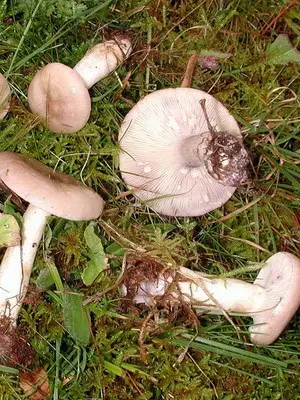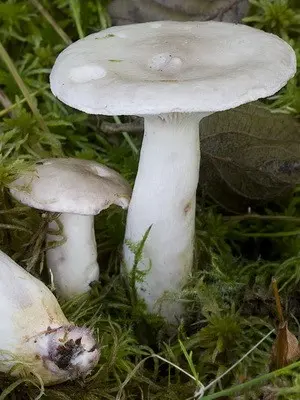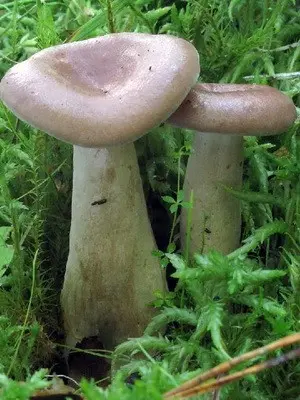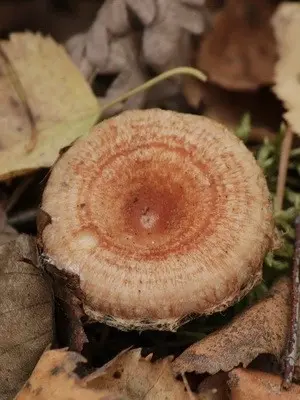Contents
 Mushrooms of the genus Milky belong to the Syroezhkov family. Their edibility category is low (3-4), however, despite this, milkers were traditionally revered in Our Country. They are still being harvested, especially those varieties that are suitable for salting and pickling. In the mycological classification, there are about 120 species of Lactarius, about 90 of them grow in Our Country.
Mushrooms of the genus Milky belong to the Syroezhkov family. Their edibility category is low (3-4), however, despite this, milkers were traditionally revered in Our Country. They are still being harvested, especially those varieties that are suitable for salting and pickling. In the mycological classification, there are about 120 species of Lactarius, about 90 of them grow in Our Country.
The first lactic ones to grow in June are non-caustic and pale yellow ones. All lactic mushrooms are edible mushrooms, and they can be distinguished by the presence of juice at the cut points or breakages. However, they, like milk mushrooms, become edible after preliminary soaking in order to eliminate bitterness. They grow in groups.
The September milkers occupy large spaces compared to the August ones, getting closer and closer to swampy places, rivers and canals.
Milk mushrooms and milk mushrooms in October change color greatly after the first frost. This change is so strong that it is difficult to distinguish between them. It is possible to use in food, soak and salt only those milkers that have not changed their appearance and properties under the influence of frost.
You can find photos and descriptions of lactic mushrooms of the most common species on this page.
Milky non-caustic
Lactarius mitissimus habitats: mixed and coniferous forests. They form mycorrhiza with birch, less often with oak and spruce, grow in moss and on litter, singly and in groups.
Season: July-October.
The cap has a diameter of 2-6 cm, thin, convex at first, later prostrate, becoming depressed in old age. There is often a characteristic tubercle in the center of the cap. The central region is darker. A distinctive feature of the species is the bright color of the hat: apricot or orange. The cap is dry, velvety, without concentric zones. The edges of the cap are lighter.
As you can see in the photo, the leg of this lactic mushroom is 3-8 cm tall, 0,6-1,2 cm thick, cylindrical, dense, then hollow, of the same color with a cap, lighter in the upper part:
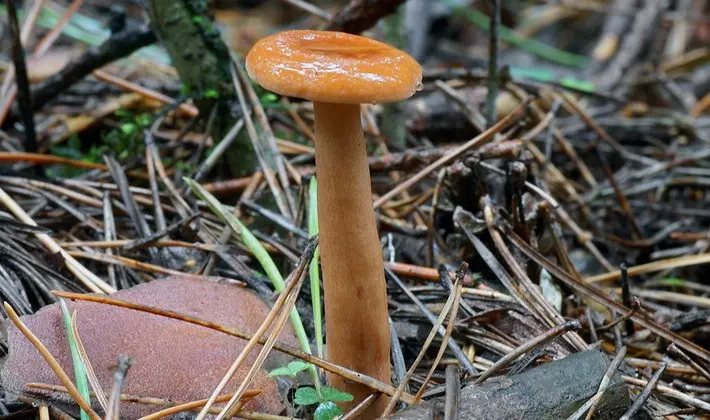
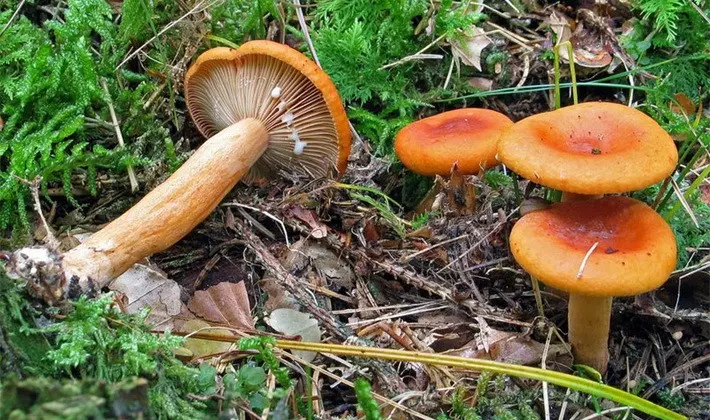
The flesh of the cap is yellowish or orange-yellowish, dense, brittle, with a neutral odor. Under the skin, the flesh is pale yellow or pale orange, without much odor. The milky juice is white, watery, does not change color in the air, not caustic, but slightly bitter.
The plates, adherent or descending, thin, of medium frequency, slightly lighter than the cap, pale-orange, sometimes with reddish spots, slightly descending to the stem. The spores are creamy-buff in color.
Variability. Yellowish plates become bright ocher over time. The color of the cap varies from apricot to yellowish-orange.
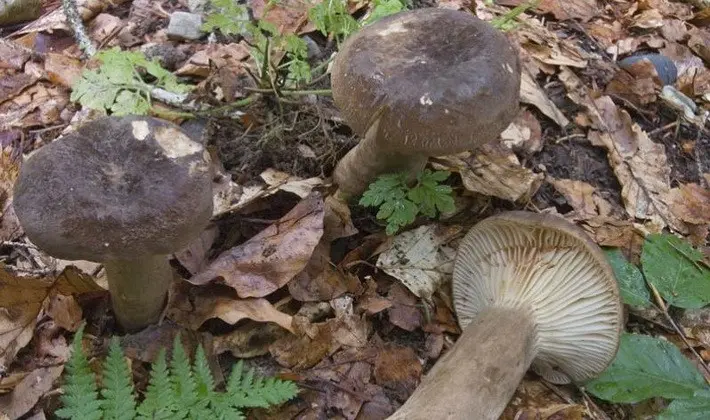
similarity to other species. The milky one is similar to Catfish (Lactatius fuliginosus), in which the color of the cap and legs is lighter and a brownish-brown color is preferable, and the leg is shorter.
Cooking methods: salting or pickling after pre-treatment.
Edible, 4th category.
Milky pale yellow
Pale yellow milkweed (Lactarius pallidus) habitats: oak forests and mixed forests, grow in groups or singly.
Season: July August.

The cap has a diameter of 4-12 cm, dense, convex at first, later flat-prostrate, slightly depressed in the middle, mucous. A distinctive feature of the species is a pale yellow, pale buff or buffy-yellow hat.
Pay attention to the photo – this lactic cap has an uneven color, there are spots, especially in the middle, where it has a darker shade:
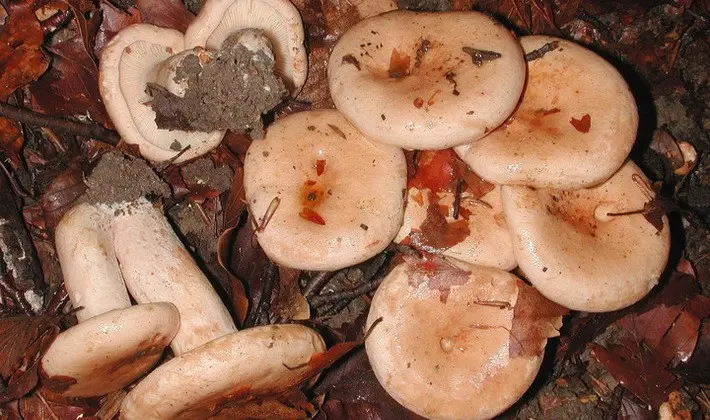
The edge of the cap often has a strong striation.
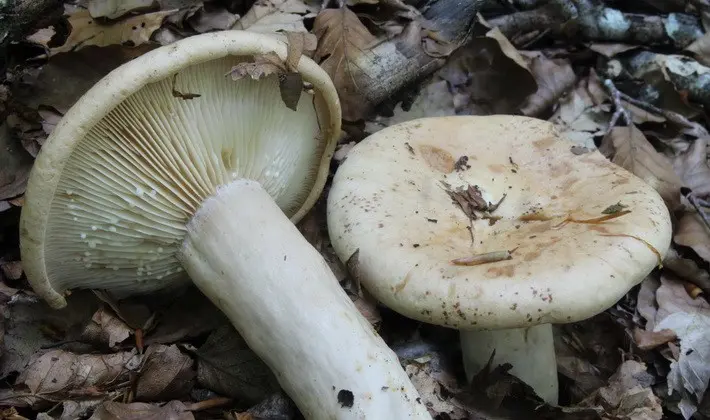
The stem is 3-9 cm tall, 1-2 cm thick, hollow, the color is the same as that of the cap, cylindrical in shape, in mature ones it is slightly club-shaped.

The flesh is white, with a pleasant smell, the milky juice is white and does not change color in the air.
The plates are frequent, weakly descending along the stem or adherent, yellowish, often with a pinkish tint.
Variability. The color of the cap and stem can vary from pale yellow to yellowish-buff.
similarity to other species. The pale yellow milky is similar to the white milky (Lactarius mustrus), whose cap color is white-gray or white-cream.
Cooking methods: edible after pre-soaking or boiling, used for salting.
Edible, 3th category.
Milky neutral
Habitats of the neutral milkweed (Lactarius quietus): mixed, deciduous and oak forests, growing singly and in groups.
Season: July-October.
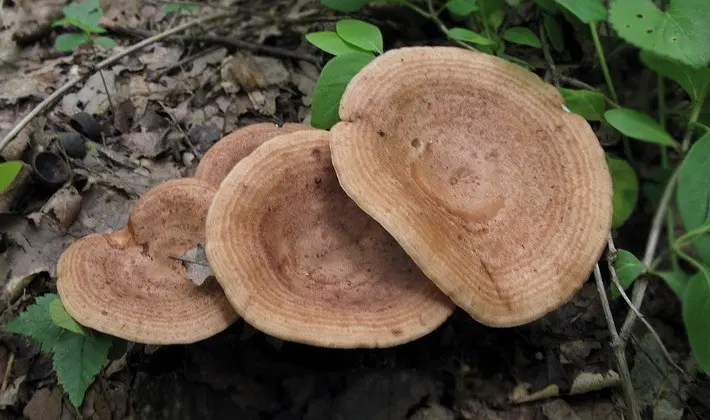
The cap has a diameter of 3-7 cm, sometimes up to 10 cm, at first convex, later prostrate, becoming depressed in old age. A distinctive feature of the species is a dry, silky, mauve or pinkish-brown hat with prominent concentric zones.
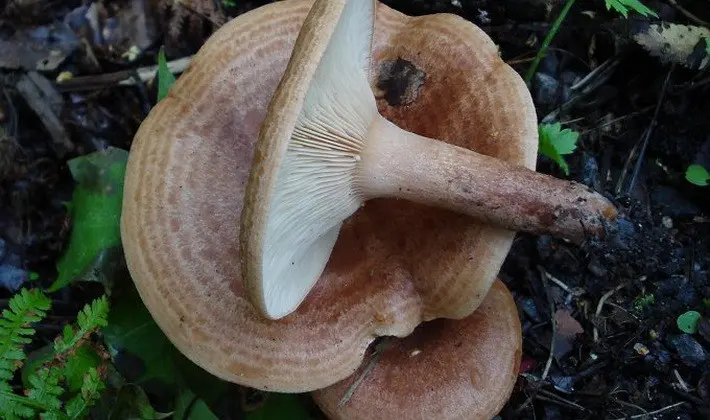
Leg 3-8 cm high, 7-15 mm thick, cylindrical, dense, then hollow, cream-colored.
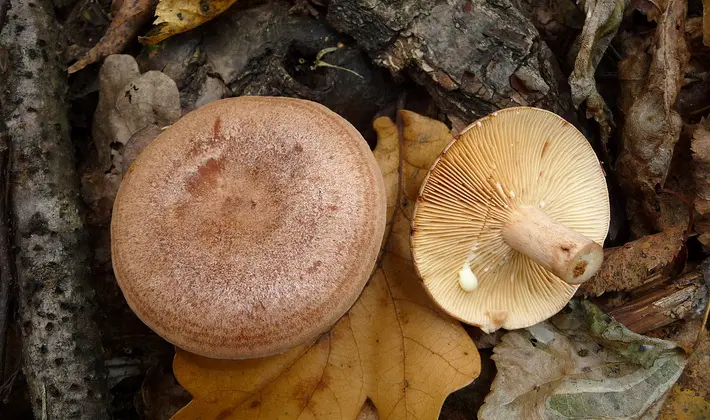
The flesh of the cap is yellowish or light brown, brittle, the milky juice does not change color in the light.
The plates are adherent and descending on the stem, frequent, cream or light brown, later becoming pinkish.
Variability: the color of the cap can vary from pinkish brown to reddish brown and creamy lilac.
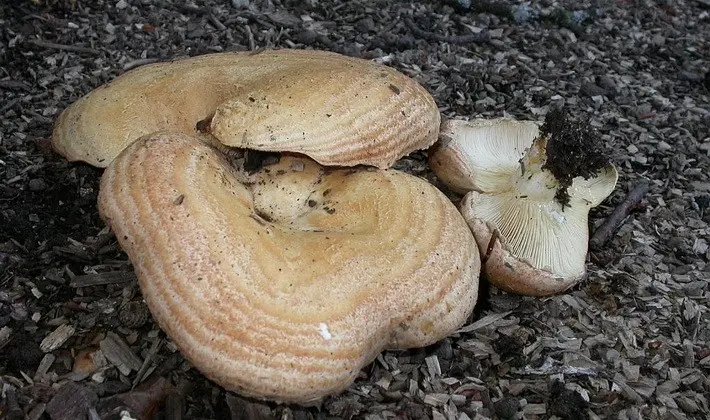
similarity to other species. According to the description, the neutral milker looks like a good edible oak milkweed (Lactarius zonarius), which is much larger and has fluffy, curled-down edges.
Cooking methods: salting or pickling after pre-treatment.
Edible, 4th category.
Milky fragrant
Habitats of fragrant milkweed (Lactarius glyciosmus): coniferous and mixed forests,
Season: Aug. Sept.
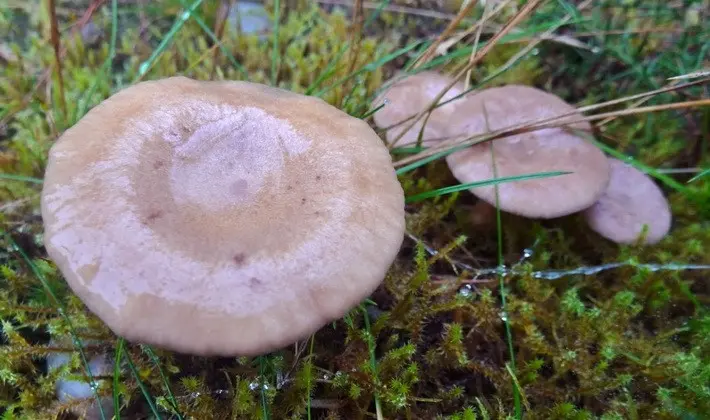
The cap has a diameter of 4-8 cm, dense, but brittle, shiny, first convex, later flat-prostrate, slightly depressed in the middle, often with a small tubercle in the center. The color of the cap is brownish-gray with a purple, yellowish, pinkish tinge.
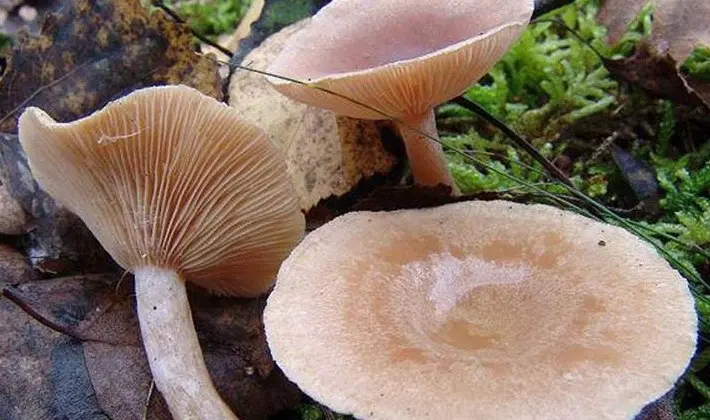
Leg 3-6 cm high, 0,6-1,5 cm thick, cylindrical, slightly narrowed at the base, smooth, yellowish.
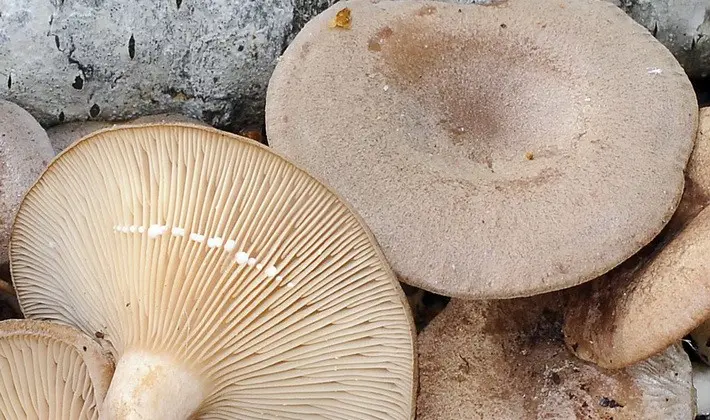
The pulp is fragile, brownish or reddish-brown. The milky juice is white, turns green in the air.
The plates are frequent, narrow, slightly descending, light brown.
Variability. The color of the cap and stem can vary from gray-brown to reddish-brown.
similarity to other species. The fragrant milky is similar to the umber milky, in which the cap is umber, gray-brown, the flesh is white, it turns brown on the cut, and does not turn green. Both mushrooms are used salted after preliminary boiling.
Cooking methods: edible mushroom, but requires preliminary mandatory boiling, after which it can be salted.
Edible, 3th category.
milky lilac
Lilac milkweed (Lactarius lilacinum) habitats: broad-leaved with oak and alder, deciduous and mixed forests, grow singly and in groups.
Season: July – early October.
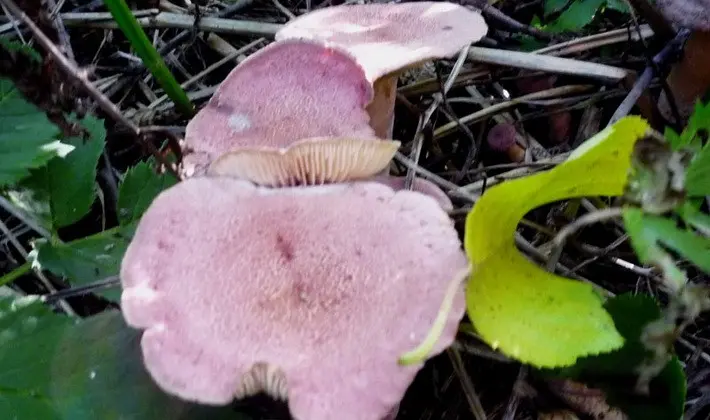
The cap has a diameter of 4-8 cm, at first convex, later convex-prostrate with a concave middle. A distinctive feature of the species is the lilac-pink color of the cap with a brighter middle and lighter edges. The cap may have slightly visible concentric zones.

Leg 3-8 cm high, 7-15 mm thick, cylindrical, sometimes curved at the base, at first dense, later hollow. The color of the stem varies from whitish to yellow-cream.
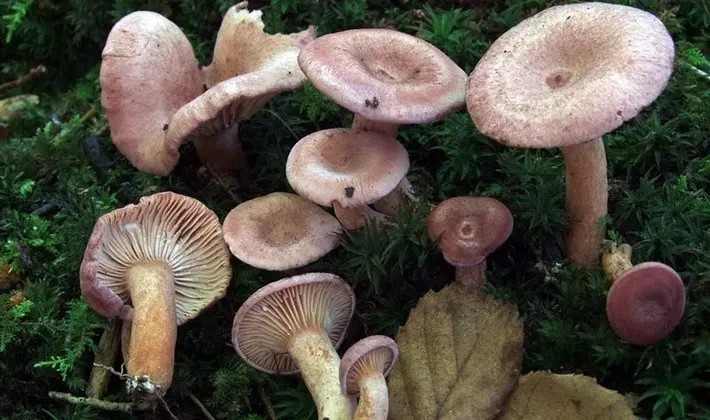
The flesh is thin, whitish-pinkish or lilac-pink, non-corrosive, slightly pungent, odorless. The milky juice is plentiful, white, in the air it acquires a lilac-greenish color.
The plates are frequent, straight, thin, narrow, adherent and slightly descending along the stem, first cream, later lilac-cream with a purple tint.
Variability: the color of the cap can vary from pinkish brown to reddish cream, and the stalk from creamy brown to brown.

similarity to other species. The milky lilac is similar in color to smooth, or common milkweed (Lactarius trivialis), which is distinguished by rounded edges and pronounced concentric zones with a purple and brown tint.
Cooking methods: salting or pickling after pre-treatment.
Edible, 3th category.
Milky gray-pink
Habitats of the gray-pink milkweed (Lactarius helvus): deciduous and mixed forests, in swamps in moss among birches and firs, in groups or singly.
Season: July-September.

The hat is large, 7-10 cm in diameter, sometimes up to 15 cm. At first it is convex with curved edges down, silky fibrous with a depression in the middle. There is sometimes a small bump in the center. Edges straighten at maturity. A distinctive feature of the species is a gray-pink, fawn, gray-pink-brown, gray-brown hat and a very strong smell. The surface is dry, velvety, without concentric zones. Dried mushrooms smell like fresh hay or coumarin.
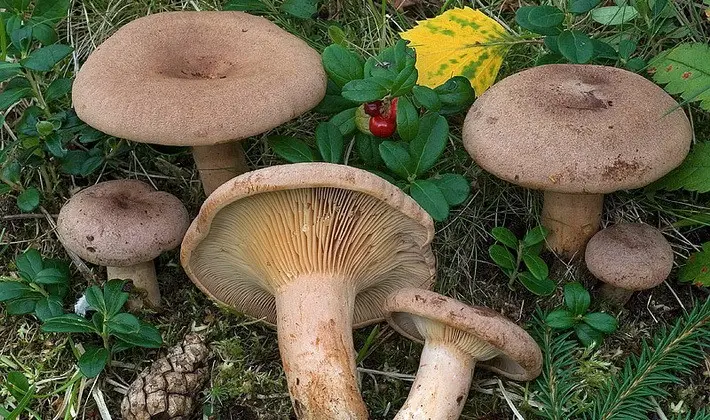
The leg is thick and short, 5-8 cm high and 1-2,5 cm thick, smooth, hollow, gray-pink, lighter than the cap, whole, strong in youth, lighter in the upper part, powdery, later red-brown.

The flesh is thick, brittle, whitish-yellow, with a very strong spicy smell and a bitter and very burning taste. The milky juice is watery, in old specimens it may be completely absent.
Records of medium frequency, slightly descending on the stem, lighter than the cap. Spore powder is yellowish. The color of the plates is yellow-ocher with a pinkish tint.
similarity to other species. By smell: spicy or fruity, grey-pink milky can be confused with oak milky (Lactarius zonarius), which is distinguished by the presence of concentric zones on a brownish cap.
Cooking methods. Milky gray-pink according to foreign literature are considered poisonous. In domestic literature, they are considered of little value due to their strong odor and are conditionally edible after processing.
Conditionally edible due to the strongly burning taste.
Milky camphor
Camphor milkweed (Lactorius camphoratus) habitats: deciduous, coniferous and mixed forests, on acidic soils, often among moss, usually grow in groups.
Season: September October.
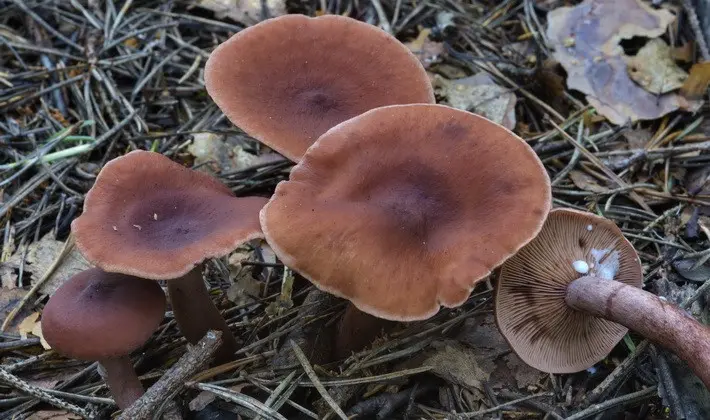
The cap has a diameter of 3-7 cm, fragile and soft, fleshy, convex at first, then prostrate and slightly depressed in the middle. A distinctive feature of the species is a well-defined tubercle in the center of the cap, often ribbed edges and a juicy red-brown color.
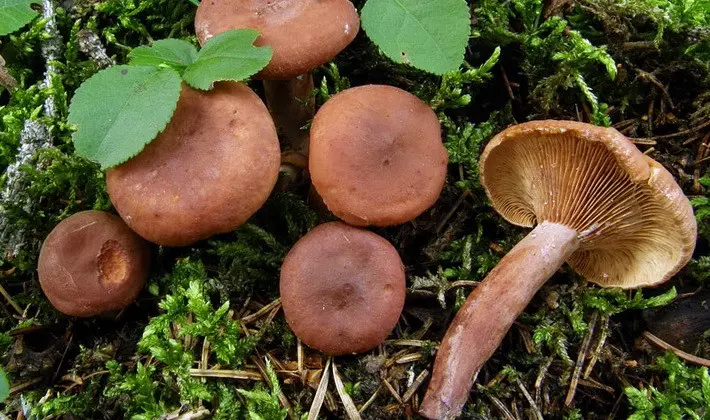
Leg 2-5 cm tall, brown-reddish, smooth, cylindrical, thin, sometimes narrowed at the base, smooth in the lower part, velvety in the upper part. The color of the stem is lighter than that of the cap.
The pulp is dense, sweet in taste. The second distinctive property of the species is the smell of camphor in the pulp, which is often compared to the smell of a crushed bug. When cut, the pulp exudes white milky sweetish juice, but with a sharp aftertaste that does not change color in the air.
The plates are very frequent, reddish-brown in color, wide, with a powdery surface, descending along the stem. Spores are creamy white, elliptical in shape.
Variability. The color of the stem and cap varies from reddish brown to dark brown and brown red. The plates can be ocher or reddish in color. The flesh may have a rusty color.
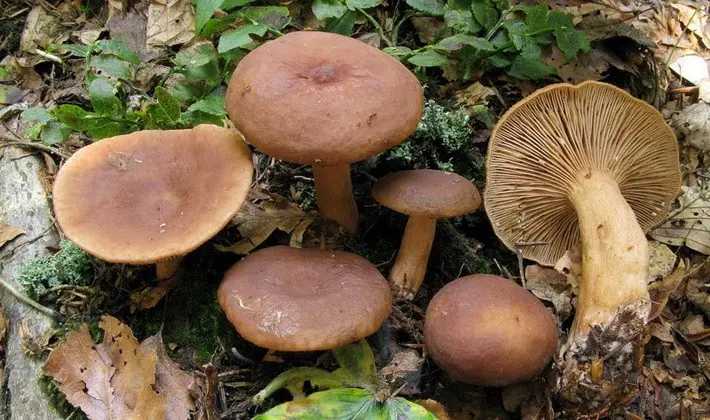
similarity to other species. Camphor milky is similar to rubella (Lactarius subdulcis), which also has a reddish-brown cap, but does not have a strong camphor smell.
Cooking methods: salting after soaking or boiling.
Edible, 4th category.
milky coconut
Habitats of coke milkweed (Lactorius glyciosmus): deciduous and mixed forests with birches, growing singly or in small groups.
Season: September October.
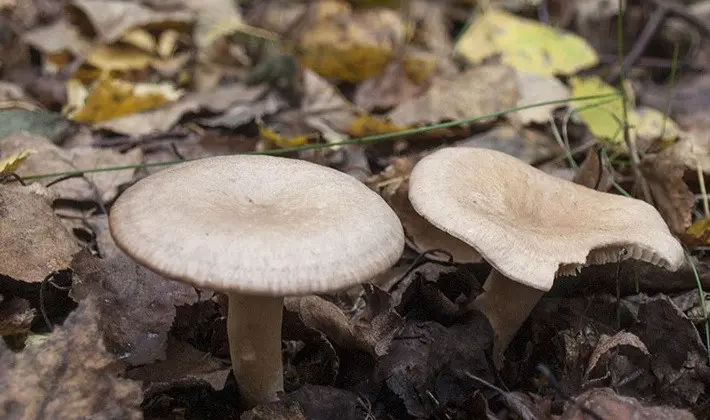
The cap has a diameter of 3-7 cm, fragile and soft, fleshy, convex at first, then prostrate and slightly depressed in the middle. A distinctive feature of the species is a gray-ocher hat with lighter thin edges.

Leg 3-8 cm high, 5-12 mm thick, cylindrical, smooth, slightly lighter than the cap.
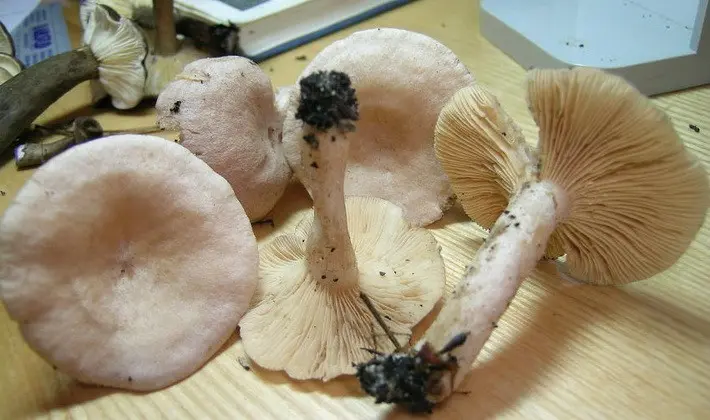
The flesh is white, dense, with the smell of coconut, milky juice does not change color in the air.
The plates are frequent, light cream with a pinkish tinge, slightly descending on the stem.
Variability. The color of the cap varies from gray-ocher to gray-brown.

similarity to other species. The coconut milky is similar to the purple milky (Lactarius violascens), which is distinguished by a grayish-brown color with pale pinkish spots.
Cooking methods: salting after soaking or boiling.
Edible, 4th category.
Milky wet, or gray lilac
Wet milkweed (Lactarius uvidus) habitats: deciduous forests with birch and alder, in humid places. Grow in groups or singly.
Season: July-September.
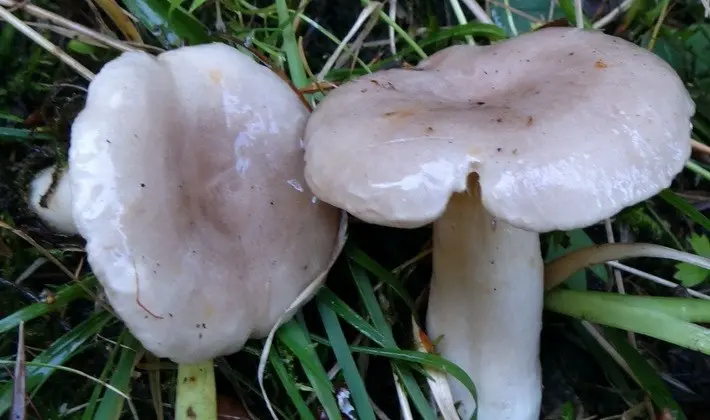
The cap has a diameter of 4-9 cm, sometimes up to 12 cm, at first convex with an edge bent down, then prostrate, depressed, smooth. A distinctive property of the species is a strongly sticky, glossy and shiny cap, pale yellow or yellowish-brown, sometimes with small brownish spots and slightly prominent concentric zones.
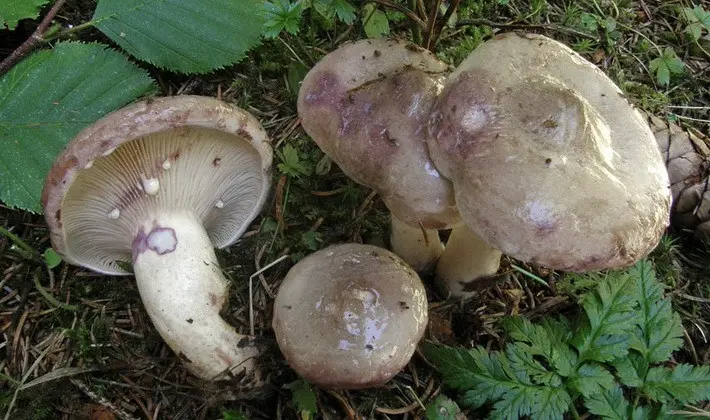
Leg 4-7 cm long, 7-15 mm thick, pale yellow with yellowish spots.

The pulp is dense, whitish, white milky juice in the air acquires a purple hue.
similarity to other species. The wet milky in shades of color and shape is similar to the white milky (Lactrius musteus), but it does not have a glossy and shiny hat, but a dry and matte one.
Cooking methods: salting or pickling after soaking for 2-3 days or boiling.
Edible, 4th category.
Here you can see photos of lactic mushrooms, the description of which is presented on this page:
